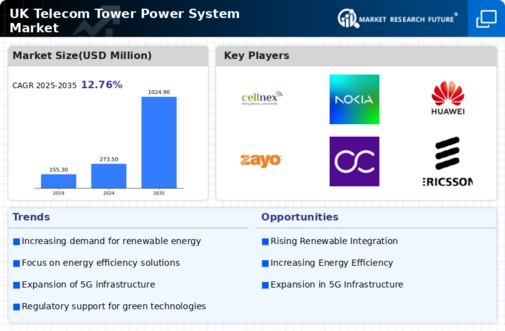Increased Focus on Sustainability
The growing emphasis on sustainability within the UK is influencing the telecom tower-power-system market. Companies are increasingly adopting green practices to reduce their carbon footprint. This shift is evident as telecom operators commit to using renewable energy sources for powering their towers. Reports suggest that over 25% of telecom operators in the UK are planning to transition to renewable energy solutions by 2026. This trend not only aligns with environmental goals but also enhances the market for innovative power systems that support sustainable energy use. Thus, sustainability is a key driver for the telecom tower-power-system market.
Rising Demand for Mobile Connectivity
The increasing reliance on mobile connectivity in the UK is a primary driver for the telecom tower-power-system market. With the proliferation of smartphones and IoT devices, the demand for robust network infrastructure has surged. According to recent data, mobile data traffic in the UK is projected to grow by over 40% annually, necessitating the expansion of telecom towers. This growth compels telecom operators to invest in efficient power systems to support the additional load. Consequently, the telecom tower-power-system market is likely to experience significant growth as operators seek to enhance their network capabilities and ensure reliable service delivery.
Rising Operational Costs and Energy Prices
The escalation of operational costs, particularly energy prices, is a significant driver for the telecom tower-power-system market. As energy costs continue to rise, telecom operators are compelled to seek more efficient power solutions to mitigate expenses. Recent statistics indicate that energy costs for telecom companies in the UK have increased by approximately 15% over the past year. This financial pressure encourages operators to invest in advanced power systems that can provide cost-effective energy solutions. Consequently, the telecom tower-power-system market is likely to benefit from this trend as companies prioritize efficiency and cost reduction.
Technological Advancements in Energy Efficiency
Technological innovations in energy efficiency are transforming the telecom tower-power-system market. The introduction of smart grid technologies and energy management systems allows telecom operators to optimize power consumption. For instance, the integration of AI-driven analytics can lead to a reduction in energy costs by up to 30%. As operators strive to lower operational expenses and meet sustainability goals, the demand for energy-efficient power systems is likely to rise. This trend indicates a shift towards more sustainable practices within the telecom sector, further propelling the telecom tower-power-system market.
Government Initiatives for Infrastructure Development
The UK government has initiated various programs aimed at enhancing telecommunications infrastructure, which serves as a catalyst for the telecom tower-power-system market. Investments in 5G technology and rural connectivity are at the forefront of these initiatives. The government has allocated approximately £1.5 billion to improve digital infrastructure, which includes the deployment of new telecom towers. This funding is expected to stimulate demand for advanced power systems that can support the increased energy requirements of modern telecom equipment. As a result, the telecom tower-power-system market is poised for growth driven by these governmental efforts.



















Leave a Comment